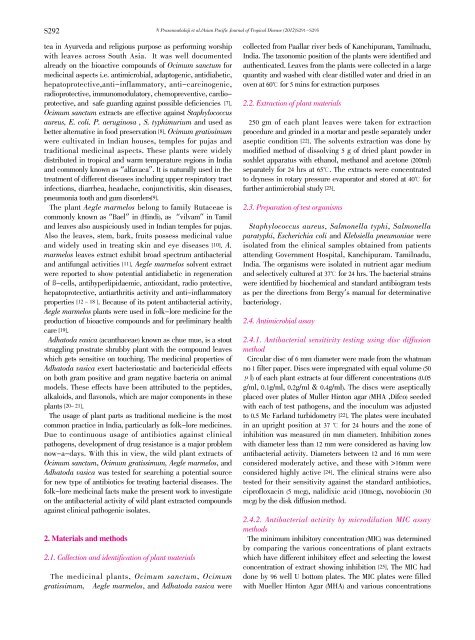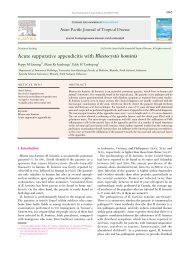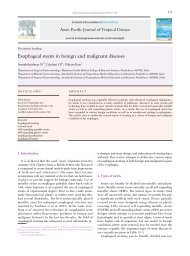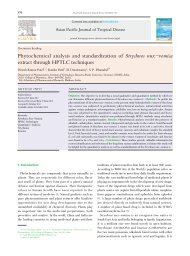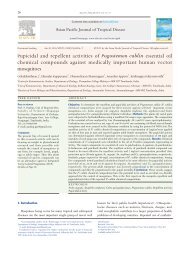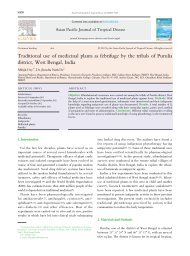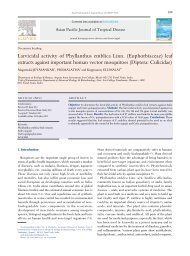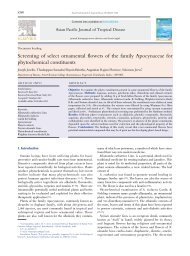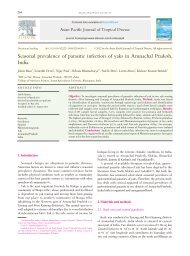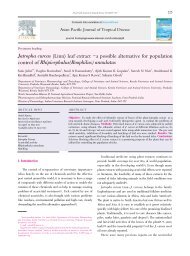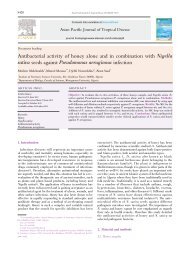Antibacterial activities of some Indian traditional plant extracts
Antibacterial activities of some Indian traditional plant extracts
Antibacterial activities of some Indian traditional plant extracts
You also want an ePaper? Increase the reach of your titles
YUMPU automatically turns print PDFs into web optimized ePapers that Google loves.
S292<br />
tea in Ayurveda and religious purpose as performing worship<br />
with leaves across South Asia. It was well documented<br />
already on the bioactive compounds <strong>of</strong> Ocimum sanctum for<br />
medicinal aspects i.e. antimicrobial, adaptogenic, antidiabetic,<br />
hepatoprotective,anti-inflammatory, anti-carcinogenic,<br />
radioprotective, immunomodulatory, chemopreventive, cardioprotective,<br />
and safe guarding against possible deficiencies [7].<br />
Ocimum sanctum <strong>extracts</strong> are effective against Staphylococcus<br />
aureus, E. coli. P. aeruginosa , S. typhimurium and used as<br />
better alternative in food preservation [8]. Ocimum gratissimum<br />
were cultivated in <strong>Indian</strong> houses, temples for pujas and<br />
<strong>traditional</strong> medicinal aspects. These <strong>plant</strong>s were widely<br />
distributed in tropical and warm temperature regions in India<br />
and commonly known as “alfavaca”. It is naturally used in the<br />
treatment <strong>of</strong> different diseases including upper respiratory tract<br />
infections, diarrhea, headache, conjunctivitis, skin diseases,<br />
pneumonia tooth and gum disorders[9].<br />
The <strong>plant</strong> Aegle marmelos belong to family Rutaceae is<br />
commonly known as “Bael” in (Hindi), as “vilvam” in Tamil<br />
and leaves also auspiciously used in <strong>Indian</strong> temples for pujas.<br />
Also the leaves, stem, bark, fruits possess medicinal value<br />
and widely used in treating skin and eye diseases [10]. A.<br />
marmelos leaves extract exhibit broad spectrum antibacterial<br />
and antifungal <strong>activities</strong> [11]. Aegle marmelos solvent extract<br />
were reported to show potential antidiabetic in regeneration<br />
<strong>of</strong> ß-cells, antihyperlipidaemic, antioxidant, radio protective,<br />
hepatoprotective, antiarthritis activity and anti-inflammatory<br />
properties [12 - 18 ]. Because <strong>of</strong> its potent antibacterial activity,<br />
Aegle marmelos <strong>plant</strong>s were used in folk-lore medicine for the<br />
production <strong>of</strong> bioactive compounds and for preliminary health<br />
care [19].<br />
Adhatoda vasica (acanthaceae) known as chue mue, is a stout<br />
straggling prostrate shrubby <strong>plant</strong> with the compound leaves<br />
which gets sensitive on touching. The medicinal properties <strong>of</strong><br />
Adhatoda vasica exert bacteriostatic and bactericidal effects<br />
on both gram positive and gram negative bacteria on animal<br />
models. These effects have been attributed to the peptides,<br />
alkaloids, and flavonols, which are major components in these<br />
<strong>plant</strong>s [20- 21].<br />
The usage <strong>of</strong> <strong>plant</strong> parts as <strong>traditional</strong> medicine is the most<br />
common practice in India, particularly as folk-lore medicines.<br />
Due to continuous usage <strong>of</strong> antibiotics against clinical<br />
pathogens, development <strong>of</strong> drug resistance is a major problem<br />
now-a-days. With this in view, the wild <strong>plant</strong> <strong>extracts</strong> <strong>of</strong><br />
Ocimum sanctum, Ocimum gratissimum, Aegle marmelos, and<br />
Adhatoda vasica was tested for searching a potential source<br />
for new type <strong>of</strong> antibiotics for treating bacterial diseases. The<br />
folk-lore medicinal facts make the present work to investigate<br />
on the antibacterial activity <strong>of</strong> wild <strong>plant</strong> extracted compounds<br />
against clinical pathogenic isolates.<br />
2. Materials and methods<br />
2.1. Collection and identification <strong>of</strong> <strong>plant</strong> materials<br />
The medicinal <strong>plant</strong>s, Ocimum sanctum, Ocimum<br />
gratissimum, Aegle marmelos, and Adhatoda vasica were<br />
N Prasannabalaji et al./Asian Pacific Journal <strong>of</strong> Tropical Disease (2012)S291-S295<br />
collected from Paallar river beds <strong>of</strong> Kanchipuram, Tamilnadu,<br />
India. The taxonomic position <strong>of</strong> the <strong>plant</strong>s were identified and<br />
authenticated. Leaves from the <strong>plant</strong>s were collected in a large<br />
quantity and washed with clear distilled water and dried in an<br />
oven at 60曟 for 5 mins for extraction purposes<br />
2.2. Extraction <strong>of</strong> <strong>plant</strong> materials<br />
250 gm <strong>of</strong> each <strong>plant</strong> leaves were taken for extraction<br />
procedure and grinded in a mortar and pestle separately under<br />
aseptic condition [22]. The solvents extraction was done by<br />
modified method <strong>of</strong> dissolving 5 g <strong>of</strong> dried <strong>plant</strong> powder in<br />
soxhlet apparatus with ethanol, methanol and acetone (200ml)<br />
separately for 24 hrs at 65曟. The <strong>extracts</strong> were concentrated<br />
to dryness in rotary pressure evaporator and stored at 40曟 for<br />
further antimicrobial study [23].<br />
2.3. Preparation <strong>of</strong> test organisms<br />
Staphylococcus aureus, Salmonella typhi, Salmonella<br />
paratyphi, Escherichia coli and Klebsiella pneumoniae were<br />
isolated from the clinical samples obtained from patients<br />
attending Government Hospital, Kanchipuram. Tamilnadu,<br />
India. The organisms were isolated in nutrient agar medium<br />
and selectively cultured at 37曟 for 24 hrs. The bacterial strains<br />
were identified by biochemical and standard antibiogram tests<br />
as per the directions from Bergy’s manual for determinative<br />
bacteriology.<br />
2.4. Antimicrobial assay<br />
2.4.1. <strong>Antibacterial</strong> sensitivity testing using disc diffusion<br />
method<br />
Circular disc <strong>of</strong> 6 mm diameter were made from the whatman<br />
no 1 filter paper. Discs were impregnated with equal volume (50<br />
毺l) <strong>of</strong> each <strong>plant</strong> <strong>extracts</strong> at four different concentrations (0.05<br />
g/ml, 0.1g/ml, 0.2g/ml & 0.4g/ml). The discs were aseptically<br />
placed over plates <strong>of</strong> Muller Hinton agar (MHA ,Difco) seeded<br />
with each <strong>of</strong> test pathogens, and the inoculum was adjusted<br />
to 0.5 Mc Farland turbidometry [22]. The plates were incubated<br />
in an upright position at 37 曟 for 24 hours and the zone <strong>of</strong><br />
inhibition was measured (in mm diameter). Inhibition zones<br />
with diameter less than 12 mm were considered as having low<br />
antibacterial activity. Diameters between 12 and 16 mm were<br />
considered moderately active, and these with >16mm were<br />
considered highly active [24]. The clinical strains were also<br />
tested for their sensitivity against the standard antibiotics,<br />
cipr<strong>of</strong>loxacin (5 mcg), nalidixic acid (10mcg), novobiocin (30<br />
mcg) by the disk diffusion method.<br />
2.4.2. <strong>Antibacterial</strong> activity by microdilution MIC assay<br />
methods<br />
The minimum inhibitory concentration (MIC) was determined<br />
by comparing the various concentrations <strong>of</strong> <strong>plant</strong> <strong>extracts</strong><br />
which have different inhibitory effect and selecting the lowest<br />
concentration <strong>of</strong> extract showing inhibition [25]. The MIC had<br />
done by 96 well U bottom plates. The MIC plates were filled<br />
with Mueller Hinton Agar (MHA) and various concentrations


